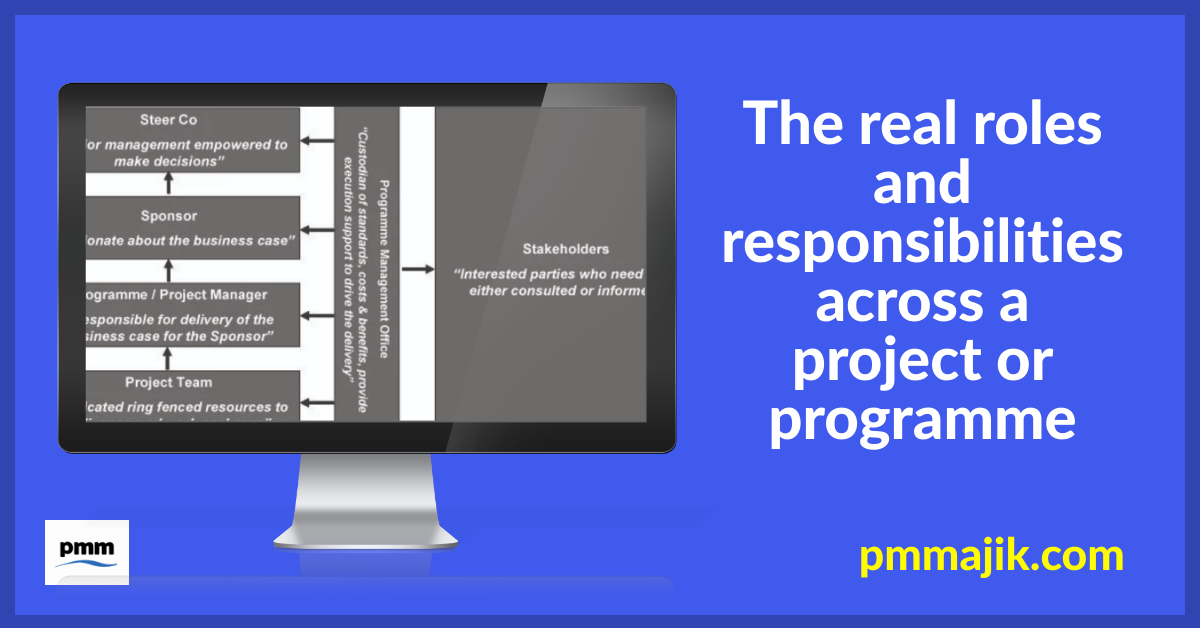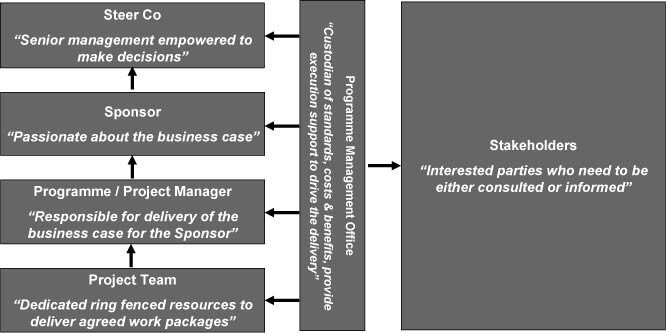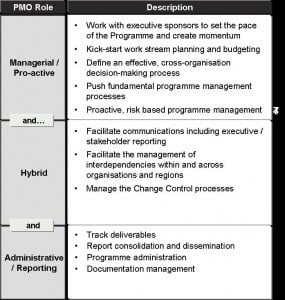A project or programme contains a number of roles. This can be confusing, especially to someone new to project management. This post explains a number of the key project roles and how they all interact.
The diagram below illustrates a typical programme governance structure. You will see the PMO is providing support and guidance at all levels.
Steering Committee (SteerCo)
This should consist of senior management members who are empowered to prioritise and make decisions. An effective SteerCo should be able to resolve and remove barriers to delivery that cannot be addressed by the programme.
Programme Sponsor
A programme sponsor is accountable for the successful delivery of a programme in line with the signed-off business case and the realisation of associated benefits. Think of the business case as being a contract between the Programme Sponsor and the organisation i.e. “give me £100 and I will deliver you £200 in savings”.
It is very important to note that, while a Programme Sponsor can delegate the delivery to a Programme Manager, they cannot delegate accountability for the business case. Therefore, it is important that they ensure that they are comfortable that a suitable Programme Manager is appointed.
A good Programme Sponsor must take an active interest in how the programme is progressing so as to ensure it is being delivered to plan and within agreed budget.
A good Sponsor will also provide the required level of support to make the Programme Manager successful. This makes complete sense as the success of the Sponsor and Programme Manager are linked.
In summary, the Programme Sponsor must be “passionate” about the business case to give the best chance to succeed.
Programme Manager
Responsible for the complete end-to-end delivery of the programme so as to deliver the business case on behalf of the Sponsor.
This means accountable for all aspects of Business, IT and 3rd party deliverables. It is no good if the Programme Manager does not feel accountable or have control of all aspects, it will result in challenges and potentially project failure.
It is a bad idea to have 2 programme managers, one responsible for Business the other for IT. This allows for accountability to fall down the “cracks in the pavement”. When problems occur, there may be unnecessary time spent debating who was responsible.
By all means appoint a programme manager for Business and one for IT if the programme is large and complex. However, have a very clearly defined programme structure showing that there is one clear programme manager responsible to the Programme Sponsor.
It should also make it clear that the IT and / or Business programme manager is reporting to the overall programme manager NOT the IT or Business function.
If you get the structure right at the beginning with clear communication, you will be on a solid foundation for success.
Project Team
This is where the work takes place to complete the work packages that make up the deliverables of the programme. Sometimes known as the “doer’s”.
The team should be structured in a way that each team member knows what they are responsible for, what they need to deliver and by when.
Where possible co-locate the team members. Not only does it make for a more efficient way of working. It greatly improves communication and most important of all, makes everyone feel part of one team.
Project / Programme Management Office
The PMO acts as the glue that brings all of the different aspects of the project together. It is the custodian of the tools and standards used to execute the project. This ensures consistency.
A very important part of the role is providing visibility and transparency of progress through robust status reporting. Acting as the central point for all participants to gain updates of progress.
A pro-active PMO will challenge progress and facilitate communication across the project. This ensures that the different participants get the information they require in a timely manner.
Stakeholders
There will usually be a number of stakeholders in the organisation who either have a vested interest, impacted or need to be consulted. Not all Stakeholders are made equal. Therefore, it is highly recommended that you conduct a Stakeholder Analysis and management plan.
The PMO is ideally placed to help the information flow to and from Stakeholders and help ease the way of the programme. Many issues actually occur because people do not feel included or opinion sort. Good communication goes a long way to address this potential issue.
Summary
While this post does not cover the normal basics of the roles and responsibilities, it more importantly provides the context of how the different ‘players’ need to interact and what is really important. The PMO plays a pivotal role in ensuring transparency and visibility of progress and facilitating the communication of information.







